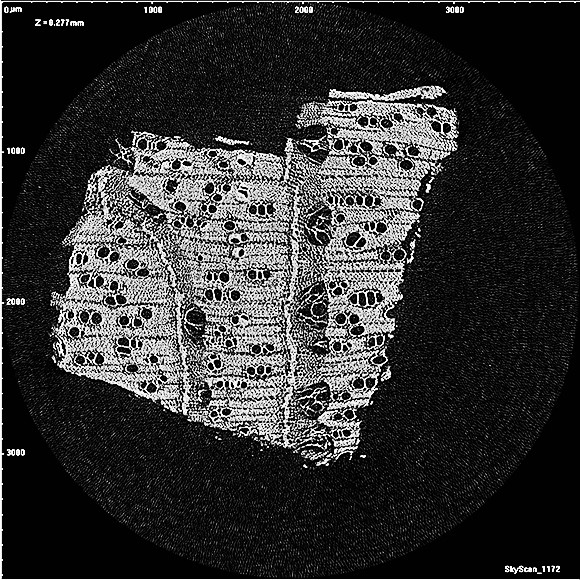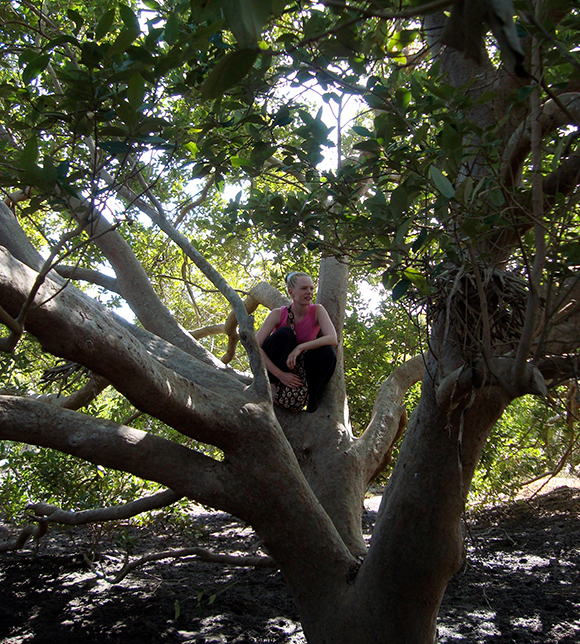Using 3D animations to understand plant anatomy

How does water move inside a tree? CREAF researchers are helping to demystify such topics using 3D images wich reconstruct the internal structure of tree branches and trunks, and further, deepening our knowledge on the transport of water and nutrients .
CREAF researchers have used CT scanning (X-ray computed tomography) and its smaller version, micro-CT scanning, to learn more about how water moves inside a tree. Images generated with these tools permit the 3D reconstruction of the internal structure of tree branches and trunks and can further deepening our knowledge on the transport of water and nutrients within these structures. The animations, recently presented at a conference in Berlin, represent a step forward in preventing the negative effects of drought on tree functioning, a phenomenon that is becoming more relevant in Mediterranean forests as a result of climate change.
Mediterranean forests are among the ecosystems that will be worst affected by global warming. With rising temperatures, it is expected that drought in this zone will increase in the coming years. Plant species will be subjected to abnormal water deficits and in the most extreme cases, some will not be able to adapt to the new climate.

Inside a tree —along with many other structures— water-transporting conduits can be found. Under normal conditions, a continuous column of water is transported within these conduits, beginning at the roots and ending at the leaves, distributing water throughout the whole organism. However, with drought, plants have a much greater demand for water than what is offered by the soil. This causes high tension in the conduits, possibly leading to rupture of the water column and causing what is known as plant embolism. Similar to embolism in the human body, embolism in a tree also implies a circulatory system blockage, with the obstruction of water-transporting conduits. In most cases, embolism consequences are less dangerous for trees than for people because of the large amount of conduits that are present in plants. However, when a tree suffers from embolism, its functioning is affected.
How can the probability of embolism in trees be reduced? This question joins Elisabeth M.R. Robert, Marie Curie researcher at CREAF, and Jordi Martínez Vilalta, CREAF researcher and professor at the Autonomous University of Barcelona. Their project PHLOEMAP has the objective to study in detail how the organs in charge of water (conduits, amongst other structures) and sugar transport work, how trees respond to water deficit, and how entire forests handle the repercussions of drought. "If we improve our understanding of how the conduits in trees are affected by insufficient water availability, we will be able to determine tree responses to drought," says Elisabeth. According to her, having this information will allow extrapolation from what occurs in a "thirsty" tree to what may happen in a forest when it dries out.

To date, deducing the 3D internal structure of tree organs such as branches required making thousands of fine cuts and observing them under a microscope. Unfortunately, this process is extremely time consuming and does not generate all required 3D information as may be needed for full understanding of the tree transport processes. Using this new methodology, Elisabeth has been able to obtain aligned series of images that allow a complete 3D view of the sample’s interior. Two types of scanners were the tools used for this study: one that uses the same technique as hospital X-ray scanners but that is adapted for very small objects, and one that is exactly the same as the one used in hospitals for diagnosing tumors.
The 3D animations related to this article have already been presented during the European conference ‘Shaping future forests – understanding tree responses to extreme climate events’ in Berlin last April. During the presentation of the videos, the faces of the researchers —and of the entire group of attendants—can be summarized in one word: surprise. Accustomed to images in only two dimensions, now they can apply their knowledge in a 3D world. "I chose two mangrove tree species (Avicennia marina and Sonneratia alba), because they have a special trunk structure allowing them to tolerate the high salt concentrations typical for this ecosystem," says Elisabeth.
Elisabeth met Jordi Martínez-Vilalta at a conference where they talked about potential projects related to drought and forests: "I was already studying how water deficit affects trees, but at that point it was only related to drought caused by high salinity levels. Jordi proposed me to apply my knowledge in plant anatomy to another kind of water deficit: drought in Mediterranean forests." Elisabeth adds, "I never thought that I would be able to come to CREAF with a Marie Curie grant. My proposal was one among 7,000." She ascribes this success to the great enthusiasm with which she took up the subject: "I was very enthusiastic about the project. I wasn't only focused on getting the grant, instead I centered my efforts on transferring my enthusiasm for studying and understanding the issue."
This road led her to generate 3D animations that allow her to achieve the project objective: to understand the effects of the lack of water in trees. The first video shows different conduits responsible for the transport and distribution throughout the whole tree of water and minerals absorbed from the soil. The study of water transport through vessels can be lifted to a new dimension with this type of 3D animations. In the second video, the internal structure of a branch can be observed. A surprise appears along the way: insects have made some tunnels inside the branch. It is important not to forget that with this technology we are travelling within a tree branch.
Related news

IPBES publishes two reports to transform the way we engage with nature, conserve it and survive




